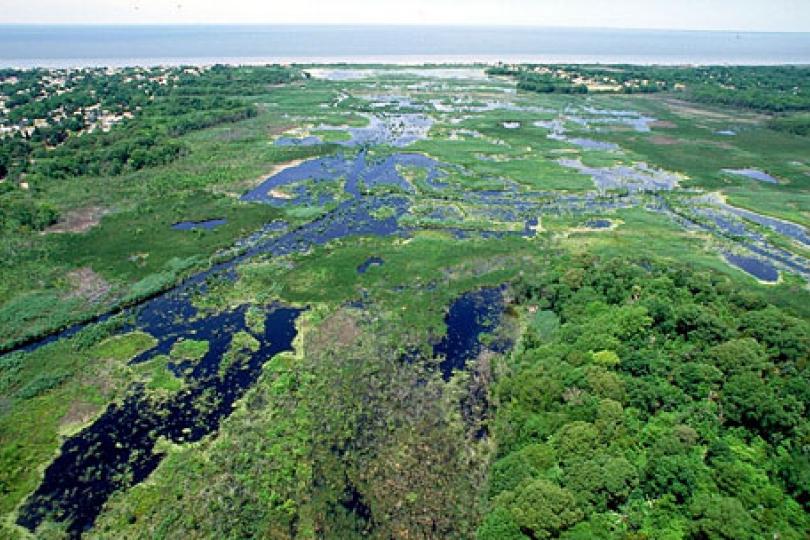The Search for Synchronicity between Wetlands and Stormwater Management
I have been working in the area of water resource policy and management for two decades and specifically on reducing the impacts of stormwater pollution for the last eleven years. At ASWM, among my many other projects, I am currently working to identify states where stormwater management considerations are being integrated into the management of wetlands and, conversely, where the protection and restoration of natural wetlands are effectively being integrated into stormwater management planning.
ASWM is looking for models where these two areas are joined effectively and for lessons learned by states and other entities trying to integrate the two. Over the last six months, I have been speaking with people both on the wetland side and the stormwater side of policy and management. And with remarkable frequency the response to the idea of integrating wetlands and stormwater management is – “Sounds good in theory, but it just doesn’t work.” This does not mean that there are no states doing this integration work well or extensively. There are. But it does beg the question – “Why is it so hard for many resource managers to think about ‘stormwater’ and ‘wetland protection’ together?”
In my discussions, stormwater folks do see the connections between runoff and streams, lakes, rivers, and the ocean, but much less frequently, wetlands. If there is discussion about wetlands, it is usually of the manmade kind. Lots of stormwater managers in New England and elsewhere around the country are excited by the findings of the New Hampshire Stormwater Center, which has shown that in many cases gravel wetlands are far more effective at capturing and treating stormwater than engineered mechanisms, detention ponds or other solutions. The “Oooh – Aaah Factor” allows the words “wetland” and “stormwater” to exist in cautious harmony. But when the conversation turns to natural wetlands, access to examples and optimism seems harder to find.
Conversations with a growing number of state wetland managers also indicate at least some level of disconnect. Wetland managers and scientists understand that water runs into their wetlands carrying pollutants. They are extremely concerned about the impacts of stormwater pollution on ecosystem health, just as other water resource managers are. Yet, when I have spoken with wetland folks about whether they have connections between the management of both programs the response is often, “no” or “not really.” It is not that they don’t care about this issue, it is more that they don’t know where to start and consequently don’t.
Some initial justifications I have heard for this disconnect during my conversations about this topic include:
- Regulator “silos” create a potentially insurmountable regulatory separation of wetlands from stormwater management;
- Lack of understanding about the other field’s science and regulations;
- Scientific uncertainties about the impacts of stormwater on wetlands and vice versa; and
- A critical lack of best practices to address interrelated impacts and opportunities.
Some specific concerns from the two different perspectives include:
Wetland Manager/Professional Concerns
- Concern that identifying connections and opportunities will lead to wetlands becoming a sink for stormwater pollutants
- Wetland systems and services should be kept entirely natural
- The value of a wetland is priceless, not worth risking compromising one by talking about it
- Fear of resource degradation
Stormwater Manager/Engineer Concerns
- Concern that wetlands are not as predictable (and consequently reliable) as engineered solutions; Hard to document input –output relationships
- Stormwater systems are more predictable and cost-effective when they are engineered
- The cost of potential non-compliance is too high; not worth the time to talk about it
- Fear of liability and regulatory fines
The problem is that water runs downhill and stormwater is impacting natural wetlands regardless of whether or not it is being discussed. ASWM’s conversations have just started, so it is our hope that further exploration will find examples of effective ways to both manage stormwater and protect natural wetlands. In the meantime, it is important to note that many of the perspectives above universally overlook the potential for other activities that connect wetlands and stormwater – opportunities for joint mapping projects, shared data and data management, joint input developing or revising municipal ordinances, pollution prevention planning, land use planning activities, and public outreach campaigns, to name a few. As I have written previously, a connection between stormwater and wetlands does not have to mean a pipe.
Examples of three states that seem to be moving towards finding effective (and very different) ways to connect the dots are Pennsylvania, West Virginia and New York.
- Conversations with Ken Murin from the Pennsylvania Department of Environmental Protection reveal that Pennsylvania has a joint permitting process for wetland impacts and stormwater. The programs use the same data, the same forms, and the same staff.
- In West Virginia, wetland and stream mitigation programs are taking a look at allowing low impact development (LID) associated with stormwater pollution prevention to be included as allowable mitigation activities.
- New York’s extensive Staten Island Bluebelt Project is a fully integrated project focused on joint management of stormwater and wetlands.
ASWM will be exploring these relationships more closely over the coming year, pointing state wetland managers and stormwater managers alike to case studies of joint management.
As part of a project to summarize state wetland programs over the next six months, ASWM will be actively seeking to document examples of states where this boundary is either actively being crossed on an ongoing basis or where there are plans to cross it. There is no convenient separation of stormwater from wetlands, whether regulatory mechanisms recognize it or not. Let us know if you are aware of states where these connections are being made successfully either at the regulatory level or through state-supported voluntary programs.
The Wetland Wanderer, ASWM’s Policy Analyst Brenda Zollitsch, will be connecting with wetland program managers in each state over the coming six months. She will be asking specific questions about these connections and welcomes information from anyone making joint efforts in the areas of wetland and stormwater management across the U.S.
Brenda can be reached at (207) 892-3399 or Brenda@aswm.org.
Additional Resources
Association of Wetland Managers
Also by Brenda Zollitsch:

